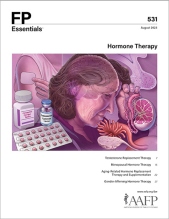
This clinical content conforms to AAFP criteria for CME.
Testosterone levels decrease as men age. When the testes fail to produce an adequate level of endogenous testosterone, men develop hypogonadism. Although the definition of a low testosterone level varies among guidelines, a serum total testosterone level of less than 300 to 350 ng/dL on two separate morning blood samples is considered a low level. To receive exogenous testosterone replacement therapy (TRT), patients should meet criteria for hypogonadism, which is defined as a low testosterone level and signs or symptoms of hypogonadism. Management discussions should be individualized to address patient needs and goals. Counseling before therapy should include shared decision-making regarding risks, benefits, and expectations. Numerous testosterone formulations are available, ranging from topical gels to intramuscular injections. The choice of formulation depends on factors such as cost and patient preference. Use of TRT is limited by contraindications, adverse effects, and a lack of long-term safety data. Patients receiving this therapy require close monitoring. For patients who wish to avoid use of exogenous hormones, are not candidates for TRT, or are unable to tolerate its adverse effects, several nonhormonal pharmacotherapies are available.
Case 1. GS is a 63-year-old patient with a history of hypertension, hyperlipidemia, and obesity. Today he comes to your office with concerns about erectile dysfunction, low libido, fatigue, and decreased energy. He discussed his symptoms with friends, who recommended that he talk to his physician about checking his testosterone level. He did some research online and thinks he meets the criteria to receive testosterone replacement therapy (TRT).
Subscribe
From $350- Immediate, unlimited access to FP Essentials content
- 60 CME credits/year
- AAFP app access
- Print delivery available
Edition Access
$44- Immediate, unlimited access to this edition's content
- 5 CME credits
- AAFP app access
- Print delivery available
